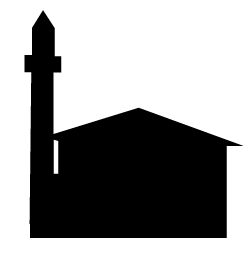Akho (ახო) village mosque door detail © all images copyright Wooden Mosques Project
Wooden Mosques explores the endangered architectural legacy of the Adjara region’s Muslim communities. This unique architecture flourished in the decades between the twilight of Ottoman rule and the rise of Soviet power. The Lesser Caucasus’ mountainous climate provided both architectural challenges and opportunities for craftsmen who traveled freely across the Georgian-Turkish border, rendering in wood and paint what would have been stone and tile elsewhere. Moreover, these mosques feature figurative decoration often thought to be forbidden by the faith. These remote structures are architectural testaments to multi-confessionalism in the Caucasus and represent a distinctive expression of vernacular mosque design that underscores the diversity of the Muslim experience worldwide. At the same time, these buildings in their design and decoration are unmistakably Georgian mosques built under Ottoman influence rather than Ottoman mosques imposed on Georgian territory.
Across Adjara, over fifty mosques built between 1817 and 1926 survive today—some the center of religious revival in their communities, others abandoned because of secularization, depopulation, or the appeal of newly-constructed mosques built with Turkish funding, materials, and design. This research project showcases many of these historic wooden mosques, selected for their diversity in location, design, and conservation status. Through an exploration of this architectural legacy, the project seeks to broaden our understanding of Georgia’s rich and varied architectural heritage.
PROJECT TEAM
Suzanne Harris-Brandts is Assistant Professor of Architecture and Urbanism at Carleton University in Ottawa, Canada. She is also a licensed architect with the Ontario Association of Architects (OAA) and a certified LEED AP BD+C. Her research brings together design and the social sciences to explore issues of power, equity, and collective identity in the built environment. It has covered topics as broad spanning as iconic state-building, incentivized urbanism, heritage, and conflict and displacement—often foregrounding the role of designer agency. Her work has been disseminated in a wide range of outlets, from books to peer-reviewed journals, design publications, lectures, and exhibitions. Harris-Brandts holds a PhD in Urban and Regional Studies from MIT and a Master of Architecture from the University of Waterloo.
Angela Wheeler is a PhD student in architecture at Harvard University's Graduate School of Design. Her work explores heritage, national identity, and architectural history in the former Soviet Union. After working with the International Council of Monuments and Sites as a Fulbright research grantee in Tbilisi, she completed an MSc in Historic Preservation at Columbia University (2016). Her thesis, Socialist in Form, National in Content, investigated the historical turn in late Soviet architecture and attempts to reconcile historic preservation with Soviet ideology in the Brezhnev era. She recently contributed a chapter on mosques of Russia and the Caucasus to Rizzoli's Mosques: Splendors of Islam (2017) and is currently writing the Tbilisi volume for DOM's Architectural Guides series.
Vladimer Shioshvili is a Georgian-American photographer who documents street art and urban transformations in Tbilisi. He enjoys setting up his tripod and exploring odd angles. Vladimer’s work has been published online and in print in Tank magazine, the Guardian, retrograd.co.uk, and the Calvert Journal.
We would like to thank the following people and organizations for their project support:
Ruslan Baramidze; David Gogishvili; Nino Inaishvili; David Sichinava; Maia Tchitchileishvili; Fritz Umbach; Ana Riaboshenko & Creative Georgia; Mariam Didebulidze and the G. Chubinashvili National Research Centre for Georgian Art History and Heritage Preservation; and all community members who helped us during our field visits.
Translation work for this project was assisted by David Sichinava and David Gogishvili.
This project is supported by the Graham Foundation for Advanced Studies in the Fine Arts and Open Society Georgia Foundation.



